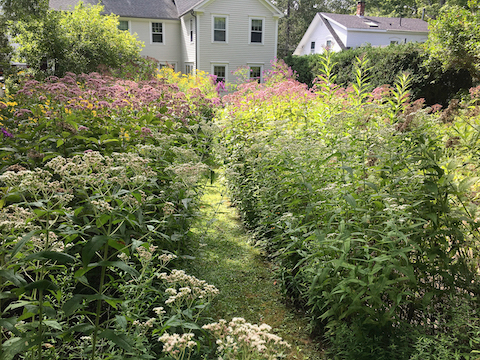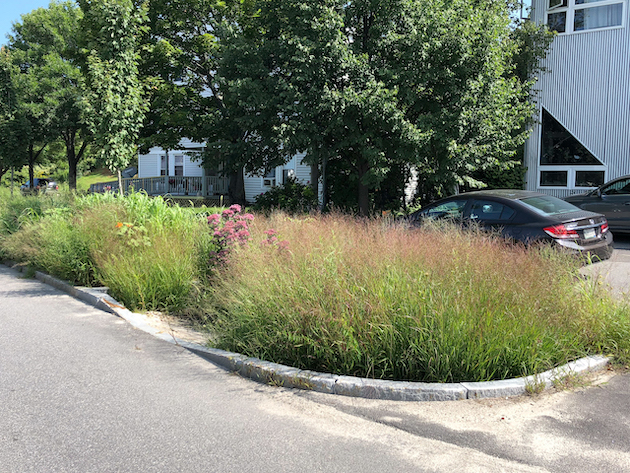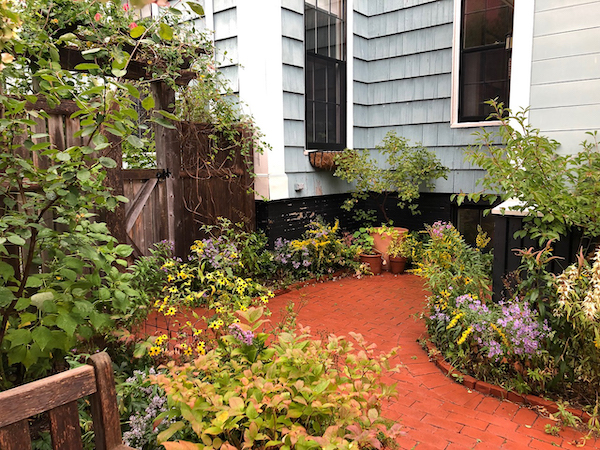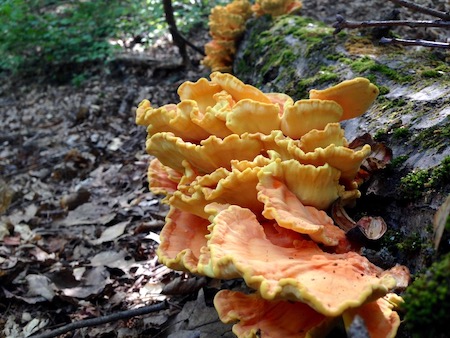Absorbing rain water back into the earth with native vegetation
By Anna Fialkoff
In a changing climate with extreme storms and floods in our present and future, forests, meadows and wetlands are increasingly vital as densely vegetated areas that act like sponges in our landscapes. They soak up massive amounts of rainfall, slow and clean water as it flows into streams and rivers and even help recharge the water table.
Unfortunately, the majority of land space in our developed areas is made up of impervious roofs and pavement, with this vital sponge largely missing. In cities and suburbs, rainwater that is not absorbed or intercepted by plants becomes dangerous runoff. Runoff is water that moves quickly across roads and sidewalks causing erosion and flooding as it picks up pollution from cars, human waste, fertilizers and pesticides along the way. It then washes into waterways and shorelines to cause atrocities like toxic algal blooms and poor water quality for aquatic and human life.
So, how do we mitigate runoff and make our built landscapes as spongy as possible? Native plants attract butterflies, bees and birds while helping absorb rainwater back into the earth. Virtually any space that is not paved can be planted: this includes yards, sidewalk hellstrips, between pavers, and around community gardens. Here are several ways to maximize your landscapes “spongability” with native plants.

Cut back on pavement and lawn.
The obvious solution to runoff is reducing the amount of impervious surfaces we have. New buildings can include green roofs, filled with tough native species that increase wildlife value while insulating and cooling a building and capturing water before it falls to ground. Traditional paving on driveways and sidewalks can be replaced with porous pavement, tracks or pavers, with low mat-forming plants like moss-phlox (Phlox subulata) or three-toothed cinquefoil (Sibbaldiopsis tridentata) in between.

Though lawn is not completely impervious, a mowed lawn is not infiltrated by water very well. The shallow root systems of common lawn species like Kentucky bluegrass (Poa pratensis) are not nearly as effective at absorbing runoff as native bunchgrasses or wildflowers with much more aboveground and belowground mass to soak up water. Consider removing unused portions of the lawn and replacing them with a native plant meadow, native edible garden (yes, there are many native edibles!), or diverse and layered planting.
A great way to transform a patch of lawn into a native planting is by “sheet mulching” it. In spring or fall, place a thick layer of overlapping cardboard pieces onto a closely cropped lawn. Then add 2 to 4 inches of aged bark mulch or composted leaves. Let it break down and smother the grass for at least three months before planting the following spring or fall.
Stack, pack and layer native plants.
Densely stacked, packed and layered plantings are much spongier than the typical ornamental plantings — which are usually sparse in plants and heavy in use of mulch or lawn — common around building foundations, parking lot islands and parks. Consider all the vertical layers of a planting and how a woven system of leaves, stems and roots can intercept, absorb and facilitate infiltration of rainwater.
Start with trees and shrubs as the foundation of plantings. Taller than other plants, their leafy canopies catch raindrops, lowering the volume and speed at which water hits the earth during heavy rainstorms. Having more mass than other plants, trees and shrubs also have more space for water storage in their deep root systems, trunks and branches. Furthermore, trees shade and cool urban areas, helping curb the urban heat island effect.

Native trees and shrubs like red maple (Acer rubrum), black gum (Nyssa sylvatica), and beach plum (Prunus maritima) are tough enough to be absorbent street trees, enduring stressors like road salt, flooding, drought, heat, air pollution and soil compaction.
Perennial wildflowers, ferns and grasses absorb rainwater, while providing flowers, foliage, and four-season beauty and attracting pollinators. Bee-magnet Joe-Pye weed (Eutrochium spp.) has fibrous roots that hold the ground tightly while soaking in fast-moving water.
Groundcovers like Pennsylvania sedge (Carex pensylvanica), running groundsel (Packera obovata) or bearberry (Arctostaphylos uva-ursi) can replace mulch altogether as they control erosion and retain moisture in the soil while filling out the spaces at the edges of paths and between and underneath taller plants.
Build deep, healthy soil.

When soil is healthy and rich with organic matter, it holds water like a sponge. It is easy to demonstrate this by scooping up a handful of construction fill soil from a suburban lot and then doing the same with soil from an old forest floor. The construction fill will not hold together easily nor stay wet very long while soil from the forest will feel squishy and moist.
Plant native trees and allow their fallen leaves and sticks to remain in place. This will not only create habitat for a wide variety of fungi and small creatures like salamanders, frogs, bees, moths and butterflies, but will also build humus, that dark, squishy carboniferous material found in old forests. The deeper the humus layer of the soil, the more water it can hold.
To jump start this process with poor soil, one could use the German Hugelkultur method, which employs large quantities of organic materials mounded into small hills or added to trenches. Logs, branches, leaves, wood chips and grass trimmings are some of the organic materials that can be used.
Keep in mind that not all native plants need rich soil. Plants of old fields, coastal plains, beaches or mountaintops prefer to be in well-drained sandy or gravelly soils with little organic matter. Little bluestem (Schizachyrium scoparium) and purple lovegrass, which thrive in the toughest highway median strips and roadsides, will be easily outcompeted by other plants in garden beds with rich soil.
Create swales and rain gardens.
It is not necessary to do major earth moving or large technical projects to make your landscape spongier. However, small and strategic changes to the topography of an area can help guide water to flow where you want it, slow it down, spread it out and sink it into the ground. This can be done with a subtle berm and swale that hugs a slope horizontally to keep the water from flowing straight downhill. Or, it can be a rain garden at your downspout.
Rain gardens are vegetated depressions — not usually more than a few inches deep — that provide an infiltration site for water from a roof, driveway or street. During storms, water temporarily fills them up and then soaks in within several hours to a day.
Durable and versatile native plants make a rain garden function optimally. Plant soft rush (Juncus effusus) or other species with strong fibrous root systems at the mouth of a rain garden to hold the soil in place as water rushes in. Shrubs like sweet pepperbush (Clethra alnifolia) and bayberry (Morella caroliniensis) make fragrant and informal hedges that withstand flooding and drought. Blue lobelia (Lobelia siphilitica) seeds into open, moist soil, making a rain garden a bumblebee-filled basin over time.
The more frequent torrential downpours and flooding events that the Northeast experiences are clear reminders that we need to make our landscapes more absorbent of precipitation. From the soil to the groundcover and from the roof to the canopy we can make our cities and suburbs into sponges, as well as green paradises for people and wildlife. As we face large, looming climate changes and biodiversity loss, revegetating where we live with native plants will ultimately bring more resilience to our communities, landscapes and ecosystems.
Additional resources:
- “A Rain Garden at Your Downspout” by Heather McCargo
- “Leave the Leaves!” by Anna Fialkoff
- “What is Rewilding?” by Heather McCargo and Anna Fialkoff
About the author:As Wild Seed Project’s ecological programs manager, Anna Fialkoff furthers the organization’s educational mission to inspire people to return native plants to the Maine landscape and works with partners to demonstrate rewilding in action.
